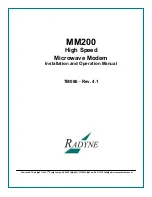
A3LA-RG Guide Version B
Document Number: 451-93156-009B
23 of 180
SIGNAL GND). These steps ensure the A3LA-RG and DTE to work together without having
hardware handshaking.
1.
The modem’s DTR line must be held high.
a.
Using the modem’s input voltage is fine for this purpose BUT ONLY if the input
voltage is less than 5 VDC (see important note below).
b.
Looping back the modem’s DSR line to DTR line will NOT work.
c.
Leave the DSR line on the modem unconnected.
2.
Disconnect the CTS, DCD, DSR, DTR, RTS, and RI lines between the DTE and modem.
3.
Set AT&Dn to AT&D0 to ignore the DTR input from the DTE.
4.
Set AT&Kn to AT&K0 for no flow control.
5.
The setting can be stored on the modem permanently (until another setting overwrites
it) so that it remains after a power cycle. The modem allows two profiles in which
settings are stored; choose either as a default profile. The relevant commands are &Wn
and &Yn.
a.
&Wn stores the present configuration in profile <n>, where <n> can be either 0 or
1.
b.
&Yn designates which profile is loaded after reset or power-up, again <n> is either 0
or 1.
6.
Address any needs of the DTE separately.
Warning
: DO NOT use the modem’s input voltage to bring the DTR line high when the input
voltage is higher than 5 VDC. Supplying voltage higher than 5 VDC to the DTR line will
permanently damage the A3LA-RG.
Note
: The Iridium’s Direct Internet service when using the Windows-based Apollo client
requires DCD to be present; hence it is incompatible with a 3-wire serial configuration. The
Direct Internet with Apollo client is available only on the EMSS DoD gateway and NOT on the
commercial gateway.
















































